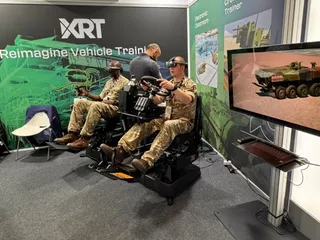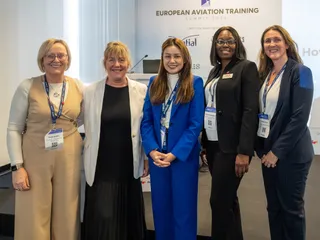- Publishing
- Topics
- Communities
- About
Rick Adams

Rick Adams, FRAeS, is Chair of the World Aviation Training Summit (WATS) pilot conference. An Aviation Journalist for 4 decades, he is Co-Founder of AviationVoices.com, former Editor of Halldale's CAT and MS&T magazines, ICAO Journal, and IFALPA Journal; a writer for several leading aviation and defence magazines; and Communications Director for leading Aerospace companies.
Rick Adams Articles & News
Refine Search
Rewatch the second episode in our series of online discussions regarding current training and simulation issues and best practices across civil aviation, military, healthcare and other safety-critical industries. 6 August 2020
Assuming everyone on board wears a mask, your risk of contracting coronavirus on an every-seat-full flight is about 1 in 4,300, according to a professor at the prestigious Massachusetts Institute of Technology. 20 July 2020
Airlines around the world are beginning to ramp up operations again. CAT Editor Rick Adams, FRAeS, outlines some of the considerations for pilots, cabin crew and maintenance technicians and the retraining required for restarting the engines.
Airlines will use this crisis to accelerate deployment of more efficient aircraft, sending some widebodies into early retirement. Maintenance technicians who have been parking thousands of aircraft on airport ramps will need to return them to flying condition, possibly in short order. Cabin crew, taught for years to engage with passengers, will now be limiting such interaction.
There’s been plenty of bad news, of course. Flight schedules reduced by 90% or more. Airline bankruptcies. Furloughs and layoffs. But there’s some encouraging news as well. Some airlines are beginning to add back routes, even open some new ones. New airlines are being launched. Flight training schools are resuming courses.
Nearly everyone has an opinion on how long it will take the airline industry to return to 2019 passenger levels and the growth levels of the past decade.
Looking to read the full article? Become a Premium Club member and gain full access today! 7 July 2020
Airlines around the world are beginning to ramp up operations again. CAT Editor Rick Adams, FRAeS, outlines some of the considerations for pilots, cabin crew and maintenance technicians and the retraining required for restarting the engines. 7 July 2020
CAT Editor-in-Chief Rick Adams, FRAeS, describes how Halldale Group is adapting to the new normal to serve the training community across multiple digital platforms. 7 July 2020
A key part of the FAA’s aircraft re-certification is a simulator training evaluation by a Joint Operational Evaluation Board (JOEB) in which pilots from around the world will be asked to validate training requirements. The JOEB is said to be primarily looking at the order and priority of checklists and memory items.
Travel restrictions related to the pandemic add uncertainty to how JOEB sessions can be conducted. The select group may perform its work remotely in flight simulators around the world, rather than transiting to Boeing’s main training center in Miami, Florida, where COVID-19 is raging anew.
Following the sim sessions, the FAA's Flight Standardization Board will propose minimum training requirements, then a public comment period, before final approval of training.
Looking to read the full article? Become a Premium Club member and gain full access today! 6 July 2020
In a US Securities and Exchange Commission (SEC) filing, Textron Inc. announced that it will halt production of commercial aviation flight simulation devices at its TRU Simulation + Training facility in Montréal, Québec, Canada, putting about 250 employees out of work. 25 June 2020
There is plenty of speculation about when airlines around the world will begin to ramp up operations again. No one yet knows when or how the resumption will play out. A major factor will be opening of borders by different nations; some countries in Europe have indicated they may not re-open until September or October, even to traffic from other EU countries. In general, though, domestic markets, especially in China and the US, are expected to gather momentum initially. International travel may come later. Passenger willingness to fly is also an unknown, and will hinge on not only ticket prices but perceived cleanliness of airports and aircraft.
When airlines begin to restart their engines, there will be several challenges, including training.
The majority of airlines’ fleets are parked in what is considered “short-term storage,” many filling up airport gates, taxiways and even runways, with the expectation of returning to service within 3-6 months. It can take as long as a week to get an aircraft “preserved,” removing fluids, installing protective casings, etc., followed by routine maintenance each month: fluid checks, idling engines to charge batteries, checking flight controls, inspecting anti-icing systems, towing with a tractor so tyres don’t get flat spots, making sure birds or insects haven’t built nests in vents.
Cabin crew re-training will also be affected. This is mostly done in house by the airline, but the numbers are large (perhaps 6-8 times as many, compared with pilots). They will need refresher and likely some additional training to cope with the “new normal” sanitary procedures.
Looking to read the full article? Become a Premium Club member and gain full access today!
23 June 2020
Over the next several weeks CAT will be releasing a series of commentaries addressing training issues in resuming airline service, post-pandemic. 22 June 2020
CAT Guest Commentary: From time to time, The Journal of Civil Aviation Training (CAT) magazine presents Guest Commentary on important issues facing the community. This commentary is offered by Professor Terry Young, Director, Dachet Consulting in Uxbridge, Greater London, UK. Herewith are some of his thoughts on re-designing the aviation infrastructure using simulation. 18 June 2020
Copyright ©2024. All Rights Reserved Halldale Group. Headless Content Management with Blaze


